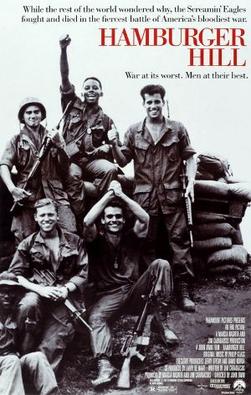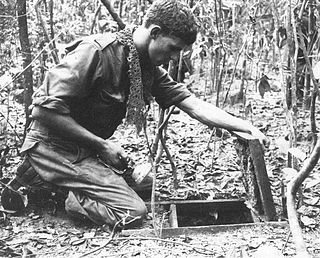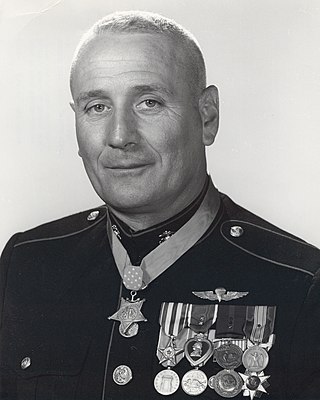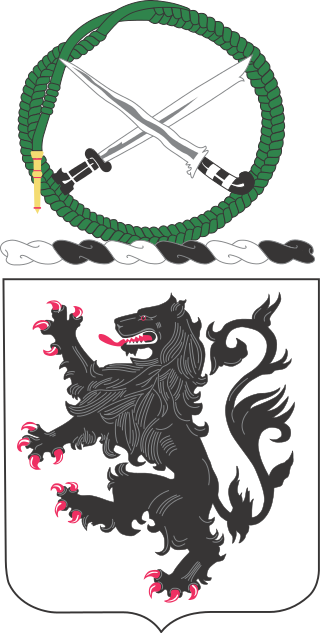
Colonel David Haskell Hackworth was a United States Army officer and journalist, who was decorated in both the Korean War and Vietnam War. Hackworth is known for his role in the formation and command of Tiger Force, a military unit from the 101st Airborne Division that used guerrilla warfare tactics against Viet Cong in South Vietnam.

The 75th Ranger Regiment, also known as the Army Rangers, is the premier light infantry unit of the United States Army. The 75th is also part of the United States Army Special Operations Command and the Department of Defense Joint Special Operations Command. The regiment is headquartered at Fort Moore, Georgia and is composed of a regimental headquarters company, a military intelligence battalion, a special troops battalion, and three Ranger battalions.

A long-range reconnaissance patrol, or LRRP, is a small, well-armed reconnaissance team that patrols deep in enemy-held territory.

Hamburger Hill is a 1987 American war film set during the Battle of Hamburger Hill, a May 1969 assault during the Vietnam War by the U.S. Army's 3rd Battalion, 187th Infantry, 101st Airborne Division, on a ridge of Dong Ap Bia near the Laotian border in central Vietnam. The ridge was a well-fortified position, including trenchworks and bunkers, of the North Vietnamese Army. U.S. military records of the battle refer to the mountain as "Hill 937," its map designation having been derived from the high elevation of the hill at 937 meters (3,074 ft).

The 2nd Ranger Battalion, currently based at Joint Base Lewis–McChord south of Seattle, Washington, United States, is the second of three ranger battalions belonging to the United States Army's 75th Ranger Regiment.

Operation Crimp, also known as the Battle of the Ho Bo Woods, was a joint US-Australian military operation during the Vietnam War, which took place 20 kilometres (12 mi) north of Cu Chi in Binh Duong Province, South Vietnam. The operation targeted a key Viet Cong headquarters that was believed to be concealed underground, and involved two brigades under the command of the US 1st Infantry Division, including the 1st Battalion, Royal Australian Regiment which was attached to the US 173rd Airborne Brigade. Heavy fighting resulted in significant casualties on both sides, but the combined American and Australian force was able to uncover an extensive tunnel network covering more than 200 kilometres, at the cost of 8 Australians and 14 Americans killed and 29 Australians and 76 Americans wounded.

Platoon Leader is a 1988 war film set in the Vietnam War and directed by Aaron Norris ; it stars Michael Dudikoff and Michael DeLorenzo and was filmed in South Africa. It is loosely based on James R. McDonough's memoir of the same name.

Jimmie Earl Howard was a Marine Corps staff sergeant when he led an eighteen-man reconnaissance patrol in a fierce battle against a battalion of Viet Cong in June 1966. As a result of his heroic actions, Howard became the sixth U.S. Marine to be awarded the nation's highest honor for heroism in combat in Vietnam. The Medal of Honor was presented by President Lyndon B. Johnson in White House ceremonies on August 21, 1967.

Captain John James McGinty III was a United States Marine Corps officer who received the United States militaries' highest decoration — the Medal of Honor — for heroism during July 1966 in the Vietnam War.

Captain Humbert Roque "Rocky" Versace was a United States Army officer of Puerto Rican–Italian descent who was posthumously awarded the United States' highest military decoration—the Medal of Honor—for his heroic actions while a prisoner of war (POW) during the Vietnam War. He was the first member of the U.S. Army to be awarded the Medal of Honor for actions performed in Southeast Asia while in captivity.

The 5th Infantry Regiment is an infantry regiment of the United States Army that traces its origins to 1808.

Puerto Ricans have served as members of the United States Armed Forces and have fought in every major conflict in which the United States has been involved from World War I onward. Many Puerto Ricans, including those of Puerto Rican descent, have distinguished themselves during combat as members of the five branches of the U.S. Military, the Army, Marines, Navy, Air Force and the Coast Guard.

The Battle of Gang Toi was fought during the Vietnam War between Australian troops and the Viet Cong. The battle was one of the first engagements between the two forces during the war and occurred when A Company, 1st Battalion, Royal Australian Regiment struck a Viet Cong bunker system defended by Company 238 in the Gang Toi Hills, in northern Bien Hoa Province. It occurred during a major joint US-Australian operation codenamed Operation Hump, involving the US 173rd Airborne Brigade, to which 1 RAR was attached. During the latter part of the operation an Australian rifle company clashed with an entrenched company-sized Viet Cong force in well-prepared defensive positions. Meanwhile, an American paratroop battalion was also heavily engaged in fighting on the other side of the Song Dong Nai.

Since the establishment of the United States Army in 1775, three regiments have held the designation 28th Infantry Regiment. The first was a provisional unit that was constituted on 29 January 1813 and served during The War of 1812. The second was a reorganization and redesignation of 2nd Battalion, 19th Infantry Regiment on 1 October 1866 for the American Indian Wars. This incarnation of the 28th Infantry Regiment lasted until 15 March 1869, when it was consolidated back into the 19th Infantry Regiment. The third version of the 28th Infantry Regiment is the one that has the permanent designation and history, and is the one this article is about.

Operation Bribie, also known as the Battle of Ap My An, was fought during the Vietnam War in Phuoc Tuy province between Australian forces from the 6th Battalion, Royal Australian Regiment and two companies of Viet Cong from D445 Battalion, likely reinforced by North Vietnamese regulars. During the night of 16 February the Viet Cong attacked a South Vietnamese Regional Force compound at Lang Phuoc Hai, before withdrawing the following morning after heavy fighting with South Vietnamese forces. Two hours later, a Viet Cong company was reported to have formed a tight perimeter in the rainforest 2 kilometres (1.2 mi) north of Lang Phuoc Hai, near the abandoned hamlet of Ap My An. In response, the Australians deployed a quick reaction force. Anticipating that the Viet Cong would attempt to withdraw, as they had during previous encounters, forces from the 1st Australian Task Force were inserted to block the likely withdrawal route in the hope of intercepting and destroying them.
Vincent Hichiro Okamoto was an American attorney, judge, author, and retired United States Army officer. An Army Ranger during the Vietnam War, he was the most highly decorated Japanese American to survive the war.

The First Battle of Loc Ninh took place during the Vietnam War that occurred between 29 October and 7 November 1967, fought by the Viet Cong, Army of the Republic of Vietnam (ARVN), Civilian Irregular Defense Group and the United States Army.

The Battle of Suoi Bong Trang was an engagement fought between US, Australian and New Zealand forces, and the Viet Cong and North Vietnamese Army during the Vietnam War. The battle occurred during Operation Rolling Stone, an American security operation to protect engineers building a tactically important road in the vicinity of Tan Binh, in central Binh Duong Province, 30 kilometres (19 mi) north-west of Bien Hoa airbase. During the fighting, soldiers from the US 1st Brigade, 1st Infantry Division and the 1st Battalion, Royal Australian Regiment, which had been attached for the operation, fought off a regimental-sized Viet Cong night assault. Repulsed by massed firepower from artillery and tanks, the Viet Cong suffered heavy casualties and were forced to withdraw by morning. After the attack, the Americans and Australians made no attempt to pursue the Viet Cong, focusing on securing the battlefield and evacuating their own casualties. The Viet Cong continued to harass the American sappers with occasional sniper and mortar fire, but these tactics proved ineffective, and the road was completed by 2 March.

The Battle of Suối Châu Pha was fought during the Vietnam War between Australian troops and the Việt Cộng. The battle took place during Operation Ballarat, an Australian search and destroy operation in the eastern Hát Dịch area, north-west of Núi Đất in Phước Tuy province. Following a covert insertion the day before which had caught a number of Việt Cộng sentries by surprise, A Company, 7th Battalion, Royal Australian Regiment had patrolled forward unaware of the presence of a large Việt Cộng main force unit nearby. Clashing with a reinforced company from the Việt Cộng 3rd Battalion, 274th Regiment, a classic encounter battle ensued between two forces of roughly equal size. Fought at close quarters in dense jungle amid a heavy monsoon rain, both sides suffered heavy casualties as neither was able to gain an advantage. Finally, after a battle lasting several hours, the Australian artillery proved decisive and the Việt Cộng were forced to withdraw, dragging many of their dead from the battlefield after having suffered crippling losses.
Company E, 52nd Infantry, (LRP) was a 120 man-sized long-range reconnaissance patrol unit attached to the 1st Cavalry Division (Airmobile) in Vietnam in 1967-69. Its origin begins on January 1, 1967, as "LRRP Detachment G2," 1st Cavalry Division (Airmobile). It was then redesignated "Headquarters & Headquarters Company LRRP Detachment" in April 1967, and redesignated "Company E, 52nd Infantry (LRP)" on December 20, 1967.

















